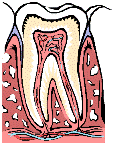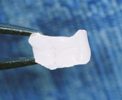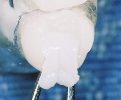This is how you can get a beautiful
smile quickly. Veneers or Laminates are a thin shell of porcelain
 or resin
that is bonded to the surface of the teeth to change their shape, shade and
position to improve the cosmetics of your teeth and smile and/or replace and
restore the lost tooth structure where it is indicated
or resin
that is bonded to the surface of the teeth to change their shape, shade and
position to improve the cosmetics of your teeth and smile and/or replace and
restore the lost tooth structure where it is indicated
Your dentist will do a complete
examination of your teeth and will
determine if veneers are indicated for
you. Usually with veneers it is possible
to improve the esthetics of your teeth
and smile dramatically.
Veneers can improve the shape of your
teeth, make your teeth as white as you
want and give you the smile you have
always wanted. Veneers are bonded to
your tooth structure, which gives them
strength.
Also because they are very thin, they
are considered one of the most
conservative cosmetic treatments
available. Most of the times very little
or no tooth structure is removed before
placing veneers. Ask your dentist how
veneers can improve your smile.


Back to Top
Every tooth consists of three different
layers. From the outside, first there is Enamel (the outer layer of the
teeth which is the hardest part of the body). The second layer is Dentin
(the inside hard layer) and then we have the Pulp (which is an empty space
where the live tissue and nerve of each tooth is located)
The second layer is Dentin
(the inside hard layer) and then we have the Pulp (which is an empty space
where the live tissue and nerve of each tooth is located)
If for any reason the pulp space is
exposed to the outside, the tissue
becomes contaminated and eventually
infected. The
exposure of pulp happens in many
circumstances for example when you have
a large cavity, or a fractured tooth.
Your dentist can explain the exact
reason for damage to this tissue.
Regardless of the reason for this
contamination or damage to pulp tissue,
the treatment is usually Root canal
treatment.
Root canal treatment is the process of
going inside the pulp space and removing
the infected and dead tissue. Then the
space is disinfected and sealed with
special materials.
Now-a-days, root canal treatments are
performed with advanced techniques and
material and are more comfortable and
faster. After root canal treatment is
done your restorative dentist will
usually place a
crown
on you tooth to protect it against
fracture.
Back to Top
When a root canal treatment fails, the
first course of action that is usually taken is trying to re-do the root
canal treatment. It is usually done by an Endodontist (root canal
specialist) or an experienced general dentist
The process is very similar to
Root canal
Treatment,
the difference is that besides taking
any remaining infected tissue out, the
doctor has to take old filling material,
any posts and crowns or any other
obstacle in the pulp space out to be
able to successfully disinfect and seal
the area of the root canal.
After the root canal treatment is done
your restorative dentist will place a
crown to protect the tooth against
fractures.
Back to Top
Inlays or onlays are lab made
restorations that are placed on teeth when the cavity or lost tooth
 structure is too large to be restored by a simple filling. The process of
making an Inlay is very similar to a crown. After the tooth is prepared it
is cemented or bonded to the tooth
structure is too large to be restored by a simple filling. The process of
making an Inlay is very similar to a crown. After the tooth is prepared it
is cemented or bonded to the tooth
There are different materials that
inlays are made of, gold, porcelain and
composite resins are among them.
Porcelain and composite inlays and
onlays are cosmetic alternatives to
fillings and are very strong compared to
regular white fillings. Gold inlays and
onlays are also good alternatives but
their appearance has made them less
popular.
Your dentist will explain to you when an
inlay or onlay is a good
treatment option for you. In general,
inlays and onlays can replace most of
back teeth fillings and provide a better
alternative to
 conventional filling. At
the same time they are more conservative
than crowns.
conventional filling. At
the same time they are more conservative
than crowns.
As far as the cost is concerned, because
the process of making an inlay or onlay
is similar to a crown, its cost is also
comparable. When long-term longevity of
inlays and onlays are considered,
though, they can end up costing less
than traditional fillings.
Back to Top
TMJ is
the joint that connects the lower and
upper jaw (skull). The terms TMJ stands
for Temporo-Mandibular Joint. This is
one the most complicated joints of the
whole body. One that allows forward and
backward moves as well as rotations and
side to side movements.
TMJ
is the joint that connects the lower and
upper jaw (skull). The terms TMJ stands
for Temporo-Mandibular Joint. This is
one the most complicated joints of the
whole body. One that allows forward and
backward moves as well as rotations and
side to side movements.
TMJ
is often referred to as the
complications and problems with this
joint. Some of the most common symptoms
of TMJ problems are:
Some
causes of the disease are genetics,
hormones, low-level infections,
auto-immune diseases, trauma, and
clenching or grinding of the teeth.
Diagnosis of such conditions and
evaluation of causes are done by
dentists experienced in TMJ problems and
treatments. Some common treatments are
Night Guards, Bite Guards and Bite
Adjustments. Your dentist will be able
to guide you toward the best treatment
for you.
If you
experience any TMJ problem or symptoms
please let us know. The doctor will be
happy to evaluate your situation and
offer the best treatment possible.
Back to Top
 Sealants are thin layers of resin that
are placed on the pits and fissures and grooves of (usually) molars to
prevent decay on these surfaces
Sealants are thin layers of resin that
are placed on the pits and fissures and grooves of (usually) molars to
prevent decay on these surfaces
Majority of decays on back teeth starts
on grooves and pits of chewing surfaces,
especially
during the first few years after their
eruption. Sealing these surfaces with
composite resins prevents these kinds of
decay.
Sealants are one of the most effective
methods of preventing decays on the
surfaces where they are places. Although
it is still a possibility that decay may
happen on surfaces in between the teeth,
sealants significantly reduce the
overall chance of having cavities.
Back to Top